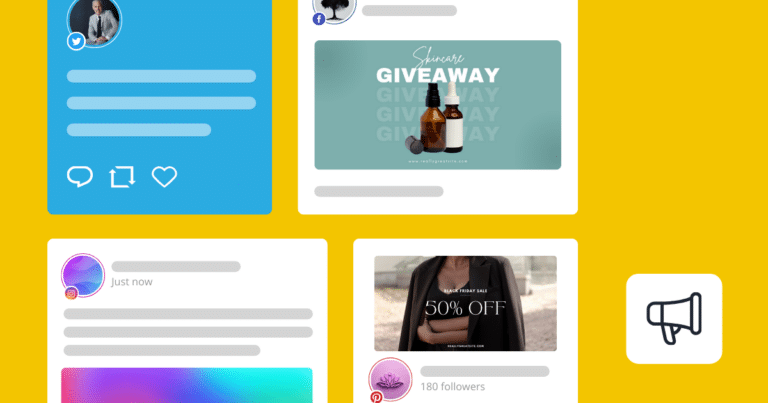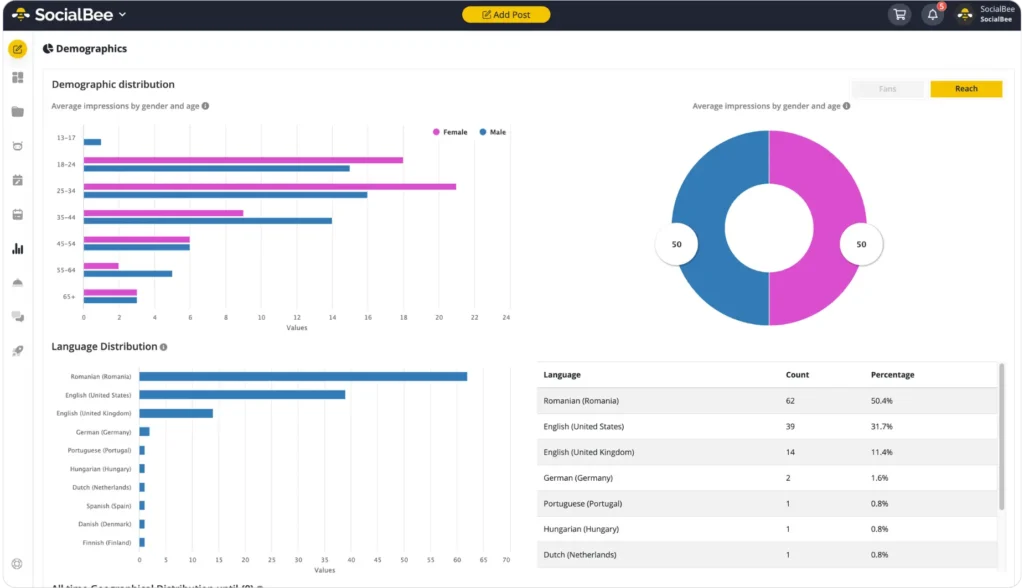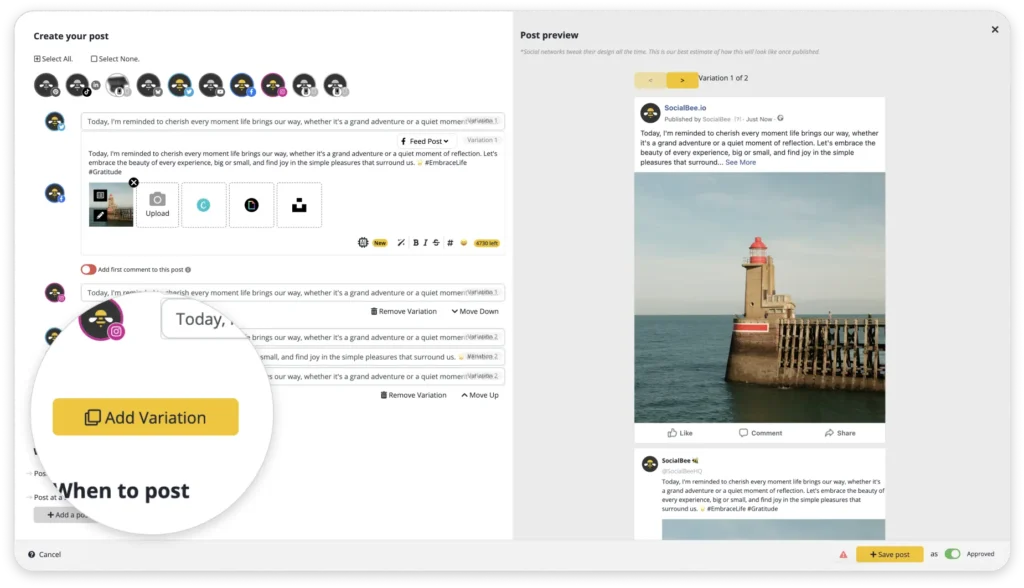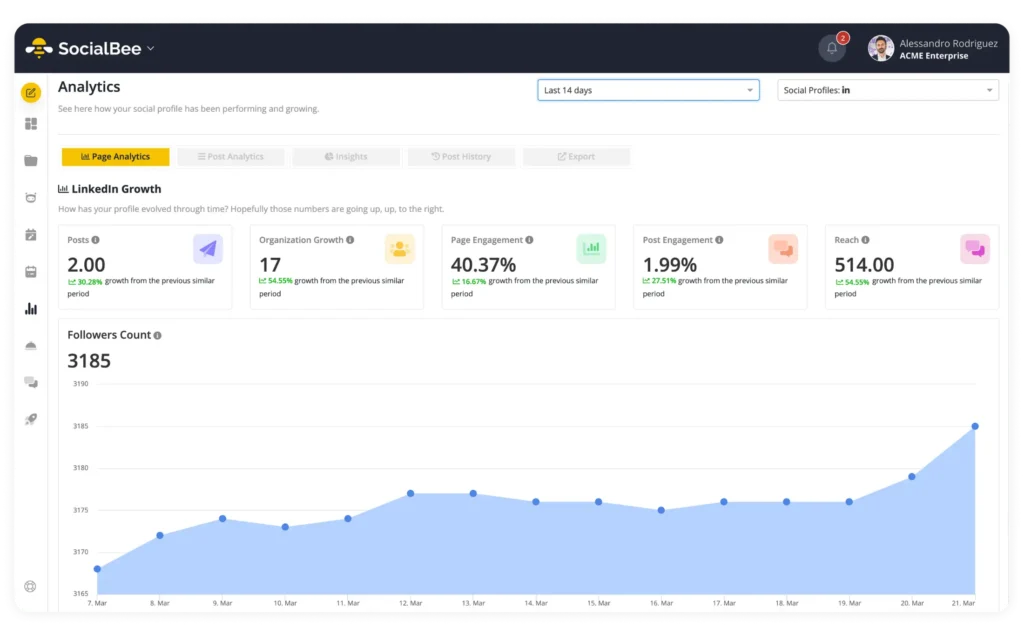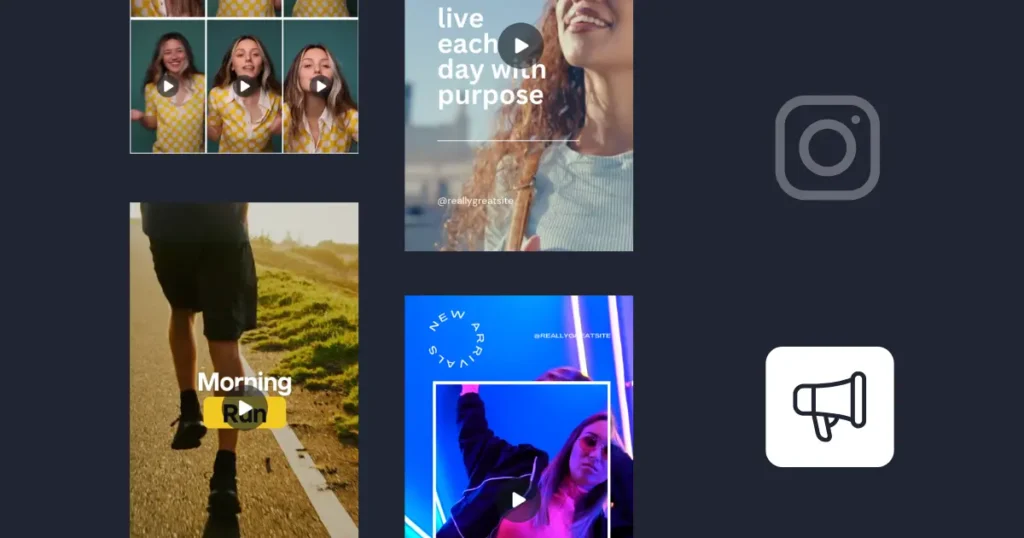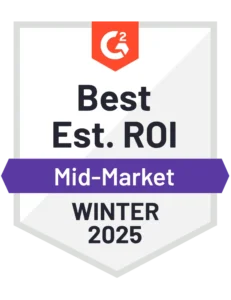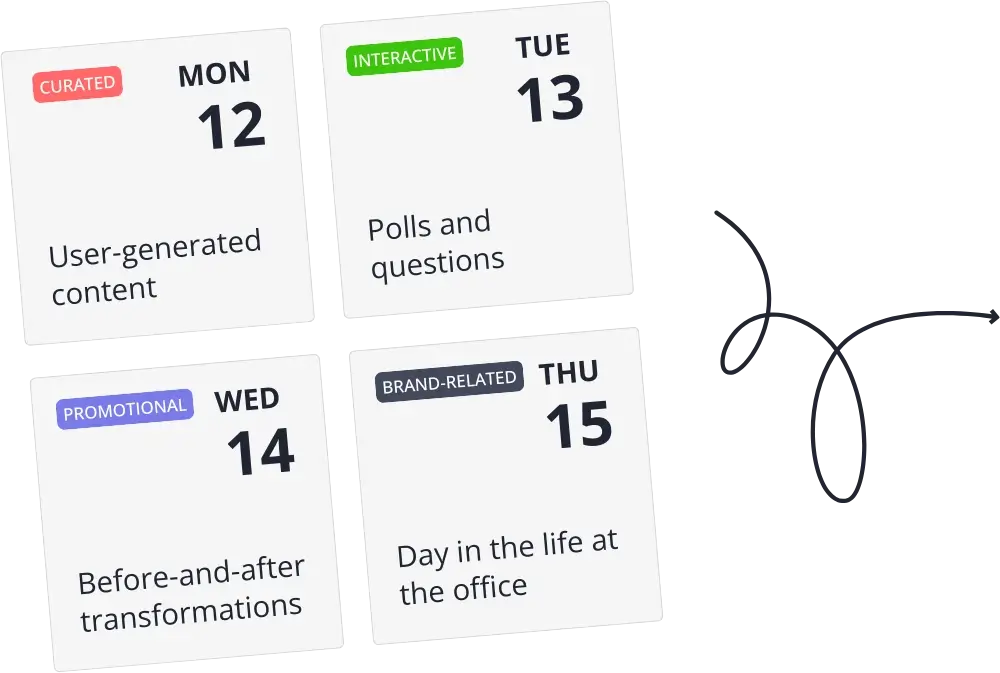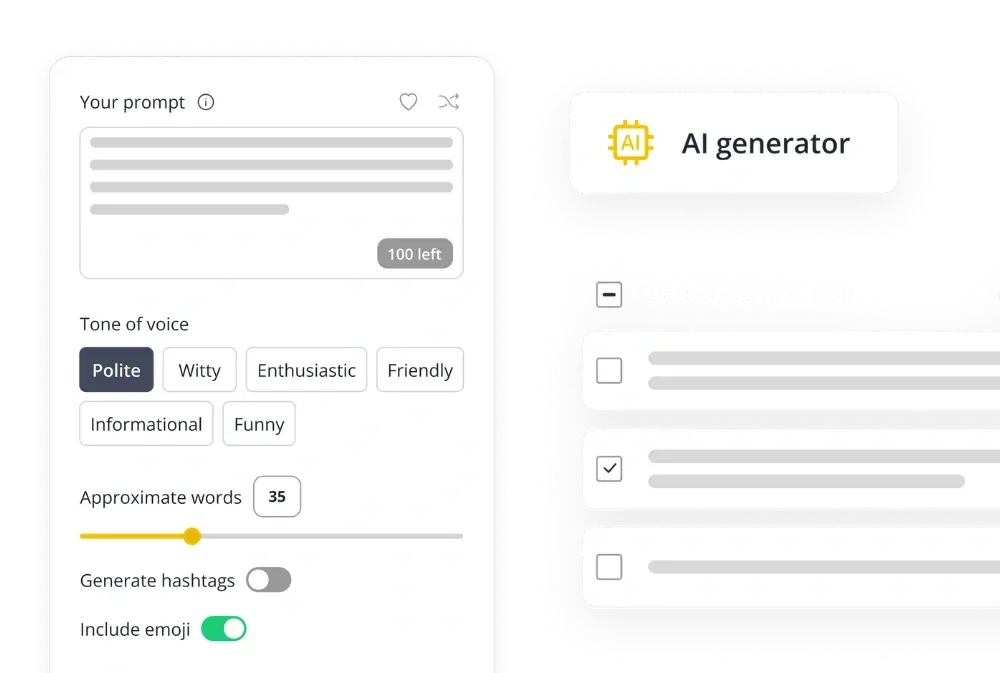
Content Writer at SocialBee
In the current landscape of digital marketing and social media engagement, you may consistently stumble upon the following dilemma: on which social network should you share content most frequently?
In this article, we’ll delve into the intricacies of identifying the perfect social media platform for you to share content on, providing valuable insights and practical guidance to help you make informed decisions that align with your marketing goals.
Whether you’re an expert in the field or just embarking on your social media journey, this is a crucial step toward maximizing your online presence and achieving tangible results. Shall we get started?
We’re SocialBee LABS SRL, part of WebPros. We use the information you provide to share relevant content and product updates, as outlined in our Privacy Policy. You can opt out anytime.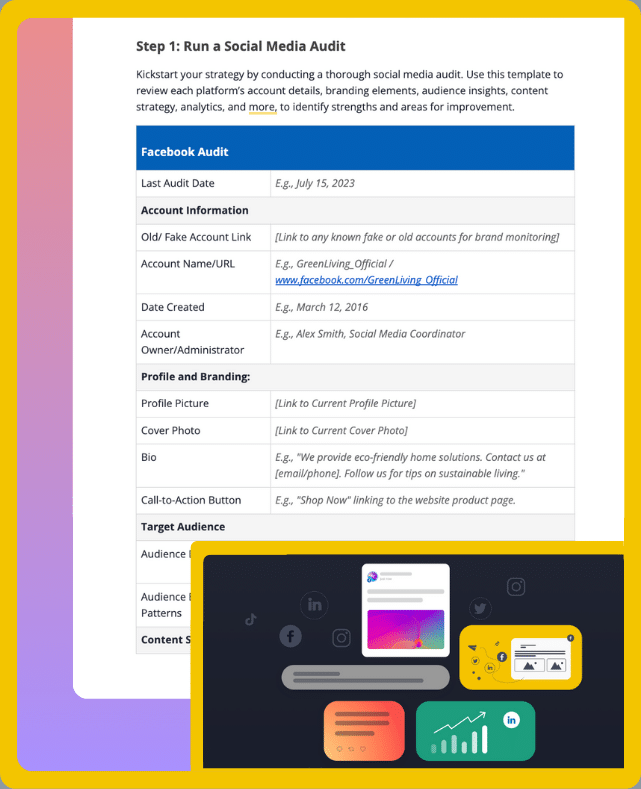
Short Summary
- Choosing the right social media platforms to share your content has a profound impact on your brand’s visibility, engagement, and overall effectiveness in reaching your target audience across various channels.
- Popular social media platforms to share content on are Facebook, Instagram, X (formerly Twitter), LinkedIn, Pinterest, Google Business Profile, TikTok, and YouTube.
- Facebook stands out with precise targeting options, making it ideal for connecting with a wide-ranging audience and fostering community engagement.
- Instagram, with its visually-driven environment, is perfect for showcasing products and appealing to a youthful, aesthetically-oriented audience.
- X (Twitter) is celebrated for its real-time updates and concise communication style, establishing itself as a hub for rapid information sharing and engagement.
- LinkedIn emerges as the go-to platform for B2B networking, enabling you to build authority and connect with experts in the industry.
- Pinterest excels in driving traffic and conversions through its visual discovery features, making it a powerhouse for showcasing products, recipes, and DIY ideas.
- Google Business Profile boosts visibility in local search results and Google Maps, which is essential when targeting nearby customers.
- TikTok offers unparalleled virality potential, making it an excellent choice for brands targeting a youthful, trend-savvy audience through short-form video content.
- YouTube, with its vast library of in-depth tutorials, product demos, and brand storytelling, caters to a diverse audience seeking information, entertainment, and education.
Table of Contents
- On Which Social Network Should You Share Content Most Frequently?
- 1. How Often Should You Post on Facebook?
- 2. How Often Should You Post on Instagram?
- 3. How Often Should You Post on X (Formerly Twitter)?
- 4. How Often Should You Post on LinkedIn?
- 5. How Often Should You Post on Pinterest?
- 6. How Often Should You Post on Google Business Profile?
- 7. How Often Should You Post on TikTok?
- 8. How Often Should You Post on YouTube?
- How to Choose the Right Social Media Networks for Your Business
- Frequently Asked Questions
- Become a Social Media Marketing Pro with SocialBee!
On Which Social Network Should You Share Content Most Frequently?
This question lies at the heart of every successful social media strategy, as it directly impacts your brand’s visibility, engagement, and overall effectiveness in reaching your target audience.
Here are the social networks you should share content on most frequently:
- Facebook: 3-7 times/week
- Instagram: 1-2 times/day
- X (formerly Twitter): 15 times/day
- LinkedIn: 3-5 times/week
- Pinterest: 3 times/day
- Google Business Profile: once/day
- TikTok: 2-3 times/day
- YouTube: 2-3 times/week
1. How Often Should You Post on Facebook?
On Facebook, you should post 3-7 times/week. Facebook, with roughly three billion monthly active users, stands out as a diverse and robust social platform, offering unparalleled reach and precise targeting options. This makes it ideal for connecting with a wide-ranging audience and fostering community engagement.
Here is how to determine whether Facebook is the best choice for your business:
Facebook Advantages |
|
Facebook Disadvantages |
|
Facebook Audience |
|
Relevant Content Types for Facebook |
|
Facebook Posting Frequency |
|
Best Times to Post on Facebook |
|
Best Facebook Practices |
|
2. How Often Should You Post on Instagram?
On Instagram, go for 1-2 daily posts. Instagram is a visually-driven environment that thrives on creative expression, making it the go-to platform for showcasing products, behind-the-scenes moments, and building a youthful, aesthetically-oriented audience.
Instagram, as a social media marketing platform, is defined by these key characteristics:
Instagram Advantages | |
Instagram Disadvantages |
|
Instagram Audience |
|
Relevant Content Types for Instagram |
|
Instagram Posting Frequency |
|
Best Times to Post on Instagram |
|
Best Instagram Practices |
|
3. How Often Should You Post on X (Formerly Twitter)?
On X, formerly known as Twitter, you should post 15 times/day. X is celebrated for its real-time updates and concise communication style, making it a hub for rapid information sharing and engagement with a global audience.
Here are the things to take into consideration before choosing X (Twitter) as your go-to platform:
X (Formerly Twitter) | |
X Advantages |
|
X Disadvantages |
|
X Audience |
|
Relevant Content Types for X |
|
X Posting Frequency |
|
Best Times to Post on X |
|
Best X Practices |
|
4. How Often Should You Post on LinkedIn?
On LinkedIn, the ideal posting frequency requires 3-5 weekly posts. LinkedIn is the go-to professional networking platform for establishing industry authority and connecting with professionals, making it a vital space for B2B and career-focused content.
These are some things to keep in mind before selecting LinkedIn as your preferred social media network:
LinkedIn Advantages |
|
LinkedIn Disadvantages |
|
LinkedIn Audience |
|
Relevant Content Types for LinkedIn |
|
LinkedIn Posting Frequency |
|
Best Times to Post on LinkedIn |
|
Best LinkedIn Practices |
|
5. How Often Should You Post on Pinterest?
For Pinterest, aim for 3 daily posts. Pinterest’s focus on visual discovery is a powerhouse for showcasing products, recipes, and DIY, making it a foolproof way to drive traffic and conversions.
Here are a few facts to consider before using Pinterest as your main social media platform:
Pinterest Advantages |
|
Pinterest Disadvantages |
|
Pinterest Audience |
|
Relevant Content Types for Pinterest |
|
Pinterest Posting Frequency |
|
Best Times to Post on Pinterest |
|
Best Pinterest Practices |
|
6. How Often Should You Post on Google Business Profile?
One daily post is optimal for Google Business Profile. The platform’s uniqueness lies in its localization capabilities, which makes it essential for local businesses aiming to reach prospective clients.
This is what you need to know when selecting Google Business Profile as your focus social media platform:
Google Business Profile | |
Google Business Profile Advantages |
|
Google Business Profile Disadvantages |
|
Google Business Profile Audience |
|
Relevant Content Types for Google Business Profile |
|
Google Business Profile Posting Frequency |
|
Best Times to Post on Google Business Profile |
|
Best Google Business Profile Practices |
|
7. How Often Should You Post on TikTok?
The ideal posting frequency for TikTok is 2-3 times/day. TikTok revolutionizes social media with short-form videos, offering virality potential, trend-driven content, and a younger audience that craves creative and authentic expression.
TikTok, as a social media marketing platform, is defined by these key characteristics:
TikTok | |
TikTok Advantages |
|
TikTok Disadvantages |
|
TikTok Audience |
|
Relevant Content Types for TikTok |
|
TikTok Posting Frequency |
|
Best Times to Post on TikTok |
|
Best TikTok Practices |
|
8. How Often Should You Post on YouTube?
Post on YouTube 2-3 times every week. This network offers a vast library of in-depth tutorials, product demos, and brand storytelling, making it a go-to destination for information, entertainment, and education.
These are the elements that will determine whether YouTube is the perfect social media choice for you:
YouTube | |
YouTube Advantages |
|
YouTube Disadvantages |
|
YouTube Audience |
|
Relevant Content Types for YouTube |
|
YouTube Posting Frequency |
|
Best Times to Post on YouTube |
|
Best YouTube Practices |
|
How to Choose the Right Social Media Networks for Your Business
Here is how to choose the right social media networks for your business:
- Understand your audience
- Consider different social media content types
- Align your onjectives with your social media content strategy
- Maintain consistency
- Use analytics to monitor performance
A. Understand Your Audience
In your quest to determine the most suitable social media networks for your business, gaining deep insights into your social media performance is crucial.
Accurate insights provide a backstage pass to creating buyer personas. These personas, detailed profiles of your ideal customers, should include demographics, psychographics, behavioral traits, motivations, challenges, preferred media, and social media habits.
We’re SocialBee LABS SRL, part of WebPros. We use the information you provide to share relevant content and product updates, as outlined in our Privacy Policy. You can opt out anytime.
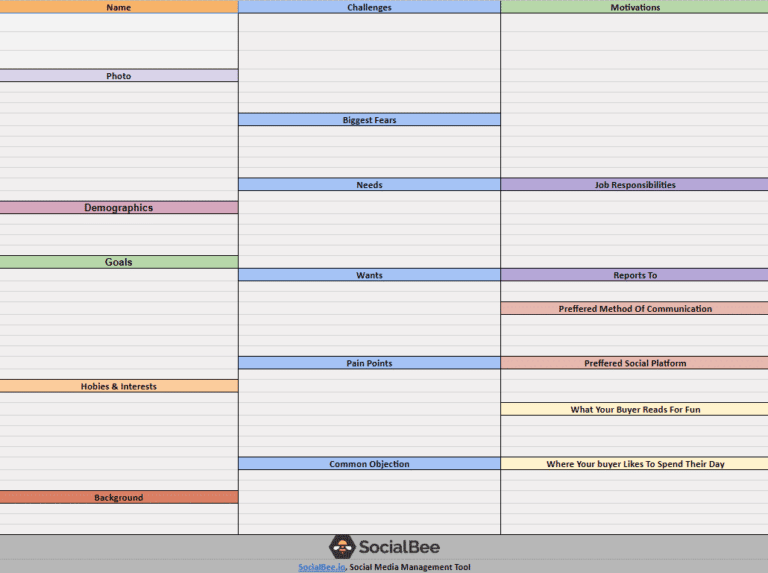
Understanding your audience through these personas requires using analytics, surveys, and market research to pinpoint where your audience spends their time online and their content preferences.
Synchronizing your target audience with the right social media platforms requires matching your personas’ characteristics with each platform’s user demographics and content strengths, alongside analyzing competitors and engagement patterns.
SocialBee‘s real-time insights can provide all the data you need about your audience’s behavior, demographics, and engagement with your posts.
Learn all about your audience with SocialBee to skyrocket your social strategy!
Start your 14-day free SocialBee trial today!
This approach empowers you to make strategic decisions on how to engage effectively with your audience. It’s a dynamic process that has numerous benefits, such as keeping your content relevant and engaging in the social media landscape.

Master Social Media Management with SocialBee!
B. Consider Different Social Media Content Types
When deciding on which social media sites to share content on, it’s important to consider the demographics of your target audience, the nature of your business (B2C vs. B2B, product vs. service), and your brand identity (tone and visual style).
This approach allows you to get very clear on the type of content you can and want to create.
Here are some content types to consider:
- Text-based posts: These include articles, thought leadership pieces, and informative posts. When crafting text-based content, focus on providing value, solving problems, and sharing insights that resonate with your audience’s interests.
- Visual content: Visuals, such as images, infographics, and graphics, are highly shareable and can quickly capture users’ attention as they scroll through their feeds. Use eye-catching visuals to convey your message effectively.
- Long-form videos: Tutorials, product demonstrations, and behind-the-scenes clips, are ideal for in-depth storytelling. They allow you to showcase your expertise, products, or services comprehensively.
- Short-form videos: Platforms like Stories, Reels, or Shorts offer the perfect canvas for engaging video content. Use these formats to share quick tips or highlight your brand’s personality.
- Interactive content: Polls, quizzes, and surveys provide an interactive and engaging way to involve your audience. They encourage participation and feedback, fostering a sense of community and keeping your audience engaged.
- Lead magnets: E-Books, whitepapers, checklists, cheat sheets, templates, tool kits, free trials, demos, webinars, and courses can help build your email list and nurture leads through your marketing funnel.
- Live videos: Hosting live sessions, Q&A sessions, or product launches in real time can foster direct engagement with your audience and create a sense of urgency.
Don’t limit yourself to a single content format. Diversifying your content mix can be highly effective. For instance, try incorporating a blend of text-based posts, images, videos, and interactive content to cater to different content preferences within your target demographic.
As a data-driven approach, A/B testing can help you determine which content types resonate best with your audience.
PRO TIP #1: Create different versions of your content using SocialBee’s post variation feature, modifying one element at a time, such as headlines, visuals, or content length.
Use SocialBee’s AI to generate multiple versions of the same posts, customized for each platform.
Start your 14-day free trial today!
After publishing your post variations, remember to track their performance metrics using SocialBee’s analytics dashboard. This will help you identify which variations generate the highest engagement and conversions.
PRO TIP #2: Begin your A/B testing with a manageable number of variations to avoid overwhelming yourself. Once you identify winning strategies, gradually scale up your efforts by incorporating them into your regular content marketing strategy.
PRO TIP #3: Extend your A/B testing to other social media networks. What works well on one platform may not perform similarly on another. Tailor your content types to the unique preferences and behaviors of each platform’s audience.
PRO TIP #4: When experimenting with content types, consider the user’s behavior and intent at each stage of the customer journey. Match your content to their specific needs, whether it’s informative, entertaining, or transactional.
C. Align Your Objectives with Your Social Media Content Strategy
To select the best social media network for your business, you must evaluate its unique features and how they align with your marketing objectives.
Start by clearly defining what you aim to achieve with your social media presence. Objectives can range from increasing brand awareness, generating leads, driving website traffic, to fostering community engagement.
Example: Real estate agency1. Marketing objective: Become an authority in the real estate field and increase local property visits and sales. 2. Social media platforms:
3. Content strategy
|
PRO TIP: Assess the resources at your disposal, including time, effort, and budget. Various platforms may demand distinct levels of investment in content creation and community management. Opt for platforms that align with your business goals and available resources.
D. Maintain Consistency
Begin by defining clear goals for your posting schedule across multiple platforms. Determine whether you aim for daily posts, weekly updates, or a frequency somewhere in between. Setting realistic and achievable posting goals is the foundation of a consistent content strategy.
To maintain a consistent presence on social media, do this:
- Plan ahead: Utilize a content calendar to map out your content, ensure a steady flow of posts, and stay organized.
- Batch your content: Allocate specific time slots for creating and scheduling multiple posts in one go to save time and streamline the content creation process.
- Leverage social media management tools: Get social media management tools to automate your posting schedule and keep your feeds fresh even during busy periods.
- Repurpose content: Reuse and repurpose existing content. Transform blog posts into infographics, create video summaries of articles, or revisit popular topics with updated insights to maximize the value of your existing assets.
SocialBee’s Evergreen Posting feature allows you to easily recycle and repurpose your most impactful content, ensuring it stays visible to audiences long after its initial posting. Its ability to automatically reshare content at regular intervals keeps your social media profiles vibrant and engaging, reducing the need for constant manual updates.
Make the most out of your already-existing content by sharing it multiple times with SocialBee.
Start your 14-day free trial today!
This is particularly valuable for those with a collection of timeless, quality content that remains relevant, effectively extending the visibility and life of their social media posts.
F. Use Analytics to Monitor Performance
Continuously monitoring and analyzing your performance across social media platforms is imperative to maximize your efforts.
Begin by defining precise KPIs and objectives that align with your overarching business goals.
For example, if you run a small online boutique and want to boost your average post engagement, you should monitor how likes, comments, and shares vary depending on the different types of posts you share.
This approach allows you to closely monitor and adjust your social media efforts to directly contribute to the primary goal of increasing online sales.
Here are the most common KPIs you can use to monitor performance:
- Engagement rates: likes, comments, shares, and interactions with your posts
- Reach: the number of people your posts reach
- Impressions: how frequently your posts were viewed, including multiple views from the same user
- Conversion rates: any actions taken by users, such as starting a trial, subscribing to a newsletter, downloading a resource, etc.
- Follower growth: followers gained vs. followers lost
Utilize tools like SocialBee to aggregate data from various social media platforms into a centralized dashboard. This approach streamlines the analysis process, enabling you to spot trends and patterns across platforms more efficiently.
Streamline your social media efforts with SocialBee’s analytics!
SocialBee’s analytics include competitor analysis, audience demographics, page analytics (followers lost and gained, page engagement and reach, hourly breakdown of your posts’ reach), and post analytics (post impressions, reach, engagement, average post performance, and best-performing content).
PRO TIP: Regularly check your metrics and adapt your strategy accordingly. Identify the types of content, posting schedules, and engagement approaches that yield the most favorable outcomes, and replicate those results.
Frequently Asked Questions
The most popular content on social media at a given moment depends on current trends and audience preferences.
However, short-form videos (think TikTok, Instagram Reels, YouTube Shorts) are kings and queens of engagement. A massive 66% of consumers find them captivating, according to a survey by Statista. Their brevity and often humorous, relatable nature make them easily digestible and hard to resist.
Pinterest, LinkedIn, and YouTube are known for having a long-lasting content shelf life:
- Pinterest: Pins on Pinterest can continue to drive traffic and engagement for months or even years. The platform’s search and discovery features allow content to resurface over time.
- LinkedIn: Content on LinkedIn, especially informative articles and posts, can have a longer shelf life, as professionals may revisit valuable industry insights.
- YouTube: Videos on YouTube have a timeless quality and can continue to accumulate views and engagement over an extended period, making it a better option for evergreen content than other social media platforms.
Facebook remains the preferred platform for business purposes. With an extensive user base, Facebook offers various ad formats and targeting options to reach your desired audience.
However, the choice of the most suitable social media platform for your business largely depends on your target audience and goals.
The secret is to identify the social media platform where your target audience spends the most time and adapt your social media strategy accordingly. Consistent, authentic, and audience-centric content will help you succeed on any platform you choose.
Become a Social Media Marketing Pro with SocialBee!
In conclusion, the decision of where to share content most frequently on social media is a critical one, as it directly impacts your brand’s visibility, engagement, and overall effectiveness in reaching your target audience.
As you embark on your social media journey, remember that it’s not just about where you share content but also how effectively you engage your audience on each platform. Make data-driven decisions, stay creative, and, most importantly, connect with your audience.
Ready to revamp your social media strategy? Start your SocialBee 14-day free trial and watch your social media marketing efforts flourish. Your audience is waiting!

